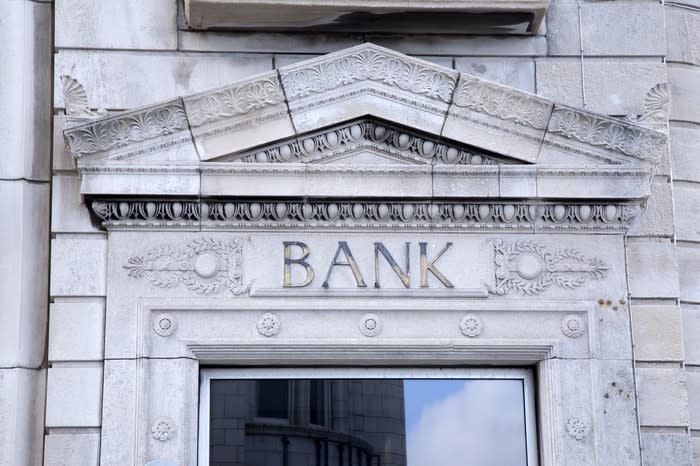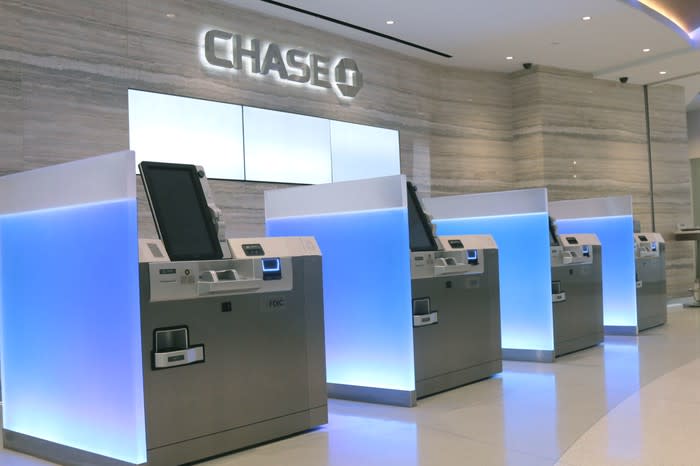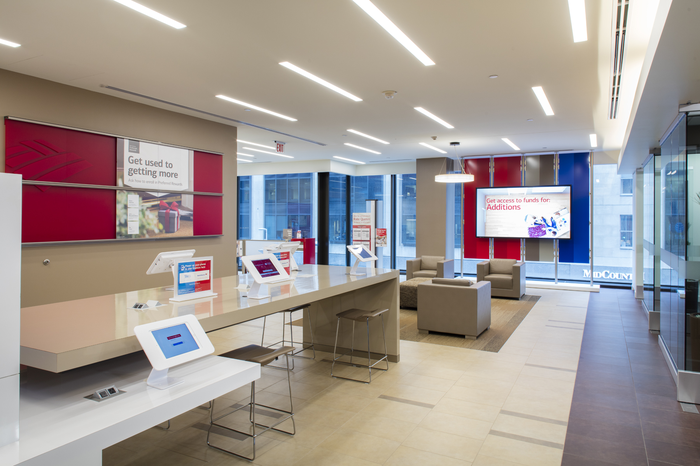Your Guide to the 10 Biggest Bank Stocks
If you're looking for investment ideas in the banking industry, it's a good idea to start with some of the largest financial institutions. Large banks often have some key competitive advantages over smaller players in the industry when it comes to brand recognition, cost of capital, and efficiency.
However, that's not to say that all large banks are the same. There's more variation among the biggest U.S. banking institutions than you might realize.

Image source: Getty Images.
With that in mind, here's a list of the 10 largest bank stocks by market cap in the United States, followed by a brief description of each one's business, growth potential, and more.
Company (Symbol) | Market Capitalization | Dividend Yield |
|---|---|---|
JPMorgan Chase (NYSE: JPM) | $362.6 billion | 2.9% |
Bank of America (NYSE: BAC) | $276.1 billion | 2.1% |
Wells Fargo (NYSE: WFC) | $213.9 billion | 3.9% |
Citigroup (NYSE: C) | $161.6 billion | 2.6% |
American Express (NYSE: AXP) | $103.2 billion | 1.3% |
U.S. Bancorp (NYSE: USB) | $83.4 billion | 2.9% |
Goldman Sachs (NYSE: GS) | $74.7 billion | 1.7% |
Morgan Stanley (NYSE: MS) | $74.3 billion | 2.8% |
PNC Financial (NYSE: PNC) | $61.7 billion | 2.8% |
BB&T Corporation (NYSE: BBT) | $37.4 billion | 3.4% |
Data source: CNBC, as of 6/28/19. Excluded banks based outside the U.S.
JPMorgan Chase: The biggest and most profitable of the "big four"
As you can see in the chart, JPMorgan Chase is the largest of the big U.S. banks by market cap. Collectively, JPMorgan Chase, Bank of America, Wells Fargo, and Citigroup are often referred to as the "big four."
JPMorgan Chase is a massive institution, boasting $2.6 trillion in assets, more than a quarter of a million employees, and a sizable presence in more than 100 different markets.

Image source: JPMorgan Chase.
The bank is also the most profitable of the big four, and by a considerable margin. Most banks are happy to produce a return on equity (ROE) of more than 10%, while JPMorgan delivered 16% in its most recent quarter. JPMorgan has substantial operations in both consumer banking and investment banking.
On the consumer banking side, credit cards have been a big area of strength recently, while investment banking has done quite well all around -- in fact, JPMorgan's first-quarter 2019 investment banking revenue was a record high for the bank.
However, because it's such a profitable and well-run institution, JPMorgan Chase isn't cheap. It trades for almost 1.6 times book value, by far the highest of the big four.
JPM Price to Book Value data by YCharts.
Bank of America: An amazing turnaround story
Like JPMorgan Chase, Bank of America has substantial operation in both consumer and investment banking, although its investment banking operation isn't quite as large.
Bank of America hasn't grown much since the end of the financial crisis. In fact, the bank's current $2.38 trillion in assets represents just 5% growth over the past eight years. However, the bank's transformation in those years has been simply remarkable. Bank of America has gone from being an institution of shaky asset quality and low profitability to being one of the most profitable and efficient of the big banks.

Image source: Bank of America.
Bank of America regularly posts strong profitability these days. In its most recent quarter, the bank generated return on assets (ROA) of 1.26% and return on equity (ROE) of 11.4%. For comparison, in the same quarter in 2013, these numbers were 0.27% and 2.1%, respectively. That's a major improvement.
Efficiency has also become a strong point. Over much of the past decade, Bank of America has been a rather inefficient banking institution, but now its efficiency ratio of 57% is among the best of the big banks. This is thanks to effective cost-reduction efforts by management as well as the bank's emergence as a technological leader. Technology can be a big money saver for banks -- for example, a mobile deposit costs a bank roughly one-tenth of what a teller-assisted deposit does. Bank of America has done a fantastic job not only of building out its mobile and online banking functionality but of getting customers to start using these platforms as well.
Wells Fargo: The most consumer-facing big bank, but with issues
Unlike the rest of the big four, Wells Fargo doesn't have a huge investment banking operation -- its business composition looks more like that of a traditional savings and loan (on a much larger scale) than you might expect from a national financial institution.
Now, Wells Fargo has generally strong asset quality and, by most metrics, is a well-run and highly profitable bank. Its net charge-off rate (the percentage of the bank's loans that is written off as uncollectable), stated on an annualized basis, is among the lowest of the big banks, and it was one of the few big banks that did quite well during the financial crisis.
The biggest issue surrounding Wells Fargo from an investment perspective is its recent sales scandals. If you aren't familiar, it was revealed in late 2016 that thousands of Wells Fargo employees had improperly opened about 2 million unauthorized accounts in an effort to meet sales goals. Not only was this figure subsequently revised upward to 3.5 million, but several other scandals came to light in the following months and years. For example, Wells Fargo allegedly charged lots of auto loan customers for insurance they didn't need, and some mortgage customers also dealt with inappropriate sales practices.
As a result of these scandals, Wells Fargo has dramatically underperformed its peers, as you can see in this chart:
In fact, for much of the previous decade, Wells Fargo was the largest bank in the U.S. by market cap and was regarded as No. 1 in terms of profitability and efficiency. It remains to be seen whether the bank will be able to successfully move on and regain its former glory -- but for now, the Federal Reserve has prohibited the bank from growing until substantial improvements are made to its culture.
Citigroup: Lots of international exposure adds to the risk
Citigroup is the cheapest of the big four banks in terms of valuation. The bank trades for just 92% of its book value (an 8% "discount"), while the next cheapest (Bank of America) trades for a 15% premium.
There are a few reasons for this, but the biggest one that investors should be aware of is that Citigroup is by far the most internationally exposed of the big banks. Just to put this into perspective, more than half of Citigroup's deposit base is international, while JPMorgan Chase, the next most international, has less than 20% of its deposits from overseas customers. For Bank of America, the percentage of international deposits is in the single digits. Citigroup has lots of exposure to emerging markets and some other areas that aren't quite as stable as the U.S.
Having said that, Citigroup's recent results have been quite strong. The bank's 0.98% return on assets (ROA) isn't quite as strong as the rest of the big four but is a big improvement over the past few years. And the bank's 57% efficiency ratio is actually one of the best among its peers.
American Express: More of a bank than you might think
Unlike other major payment networks like Visa (NYSE: V) and Mastercard (NYSE: MA), American Express is a closed-loop payment network. When you see a Visa logo on a credit card, for example, this means that Visa is serving as an intermediary between a bank and the merchants who accept the card. On the other hand, American Express is the bank. When you pay for a purchase with your AmEx card, American Express is lending you the money.
American Express has done an excellent job of building out its business over the past few decades. For starters, American Express has historically focused on the upper end of the market, but it now has a wide range of credit cards, including several no-fee products that are highly competitive. And the company has done an excellent job of creating higher-end products that today's consumers want -- for instance, the recently revamped flagship Platinum Card by American Express has benefits like free Uber rides, which are helping the company win over the critical millennial demographic.
Furthermore, Amex has done a fantastic job of increasing its merchant acceptance rate. The dreaded "Sorry, we don't take American Express" line isn't exactly a thing of the past, but American Express' reach within the United States has grown dramatically. And with a cardholder base that spends three times as much, on average, as other card brands, American Express certainly has an advantage when it comes to merchants wanting access to its customers.
In short, American Express is not like other credit card brands and is more of a consumer lender than you might think. With a desirable cardmember base and the ability to benefit from both sides of a card payment transaction (merchant fees plus interest charges), American Express is quite a unique bank stock.
U.S. Bancorp: The best-run big bank, but you'll pay for it
U.S. Bancorp is primarily a consumer bank, meaning that it doesn't have a large-scale investment banking operation. Although it's well below the big four in terms of market cap, U.S. Bancorp deserves notoriety for consistently being the most profitable and stable of the largest banks. Check out this 10-year chart of U.S. Bancorp's ROA and ROE compared with its larger siblings. (Note: USB is the purple line in the charts.)
WFC Return on Assets (TTM) data by YCharts.
Plus, U.S. Bancorp's earnings never went negative during the financial crisis, and not too many of the large U.S.-based banks can say that.
The caveat is that U.S. Bancorp is an expensive bank stock. With a current share price that is 1.83 times book value, the bank is certainly on the high end.
Bank | Price-to-Book Multiple |
|---|---|
U.S. Bancorp | 1.83 |
JPMorgan Chase | 1.59 |
Wells Fargo | 1.23 |
Bank of America | 1.15 |
Citigroup | 0.92 |
Data source: YCharts, as of 7/1/19.
The best way to sum up U.S. Bancorp as an investment is that it's expensive, but you'll get what you pay for.
Goldman Sachs: The next big consumer bank?
Historically, Goldman Sachs has been an investment bank and a wealth management firm catering to the wealthiest clientele. However, this has changed in recent years, and management has made clear that the evolution isn't done just yet.
Goldman Sachs first entered the consumer banking space when it launched its Marcus personal lending platform in late 2015. The company's unique no-fee and consumer-oriented lending approach (when you call Marcus during business hours, a live person, not a recording, answers the phone) has been a hit with consumers. The company's high-yield deposit platform has been extremely successful as well.
This could just be the tip of the iceberg. Goldman is about to jump into the credit card business head first by partnering with Apple (NASDAQ: AAPL) on its new Apple Pay credit card, and we also know that there's an investment platform for everyday Americans in the works. Current CEO David Solomon has mentioned several other potential growth avenues, such as mortgages, auto loans, checking accounts, insurance products, and more. With Goldman Sachs' brand and resources and no legacy branch infrastructure to worry about, there's a lot of potential here.
In the meantime, Goldman's core investment banking operation is doing well. The bank ranks No. 1 in terms of completed M&A transactions, as well as in worldwide equity and common stock offerings, and it should be a big beneficiary of the wave of IPOs and mergers we've been seeing in 2019.
Morgan Stanley: Investment banking and more
Morgan Stanley is more of a pure play on investment banking than Goldman Sachs, and this is likely to be even more true as Goldman's consumer-facing business gets built out over the coming years. However, it is worth mentioning that Morgan Stanley does have a "Main Street"-focused robo-advisor platform known as Morgan Stanley Access Investing.
Most of Morgan Stanley's revenue comes from a combination of M&A advisory, underwriting, trading, wealth management, and investment management.
Goldman Sachs' consumer banking ambitions could certainly add tons of revenue, but Morgan Stanley has been producing somewhat better investment banking results recently -- for example, while trading revenue has been a weak point throughout the industry, Morgan Stanley's most recent results handily beat expectations.
PNC Financial: An up-and-comer with a big endorsement
PNC Financial is a regional bank based in Pittsburgh and is primarily a consumer-focused (noninvestment) bank. It operates primarily on the east coast and has a physical presence in 17 states. With $228.5 billion in loans and $267.2 billion of deposits, PNC is larger than most regional banks but is significantly smaller than the big national financial institutions we've covered here. One of PNC's primary focuses is middle-market businesses, a market to which it is one of the leading credit providers, and the company also owns a minority stake in investment management firm BlackRock.
One notable development is that PNC recently found its way into Berkshire Hathaway's (NYSE: BRK-A) (NYSE: BRK-B) stock portfolio. Warren Buffett is a big bank stock investor, with positions in several of the banks on its list, but PNC is a more recent addition, which indicates Buffett believes the return potential is as strong as or greater than that of the larger banks.
BB&T: Soon to be known as...
BB&T is about to soar quite a bit higher on this list -- well, sort of. The company has entered into an agreement to complete a "merger of equals" with fellow regional bank SunTrust (NYSE: STI), in the largest bank M&A deal since the financial crisis. The combined bank, which will be known as Truist, will be the sixth-largest bank in the United States -- almost the exact same size as U.S. Bancorp.
Here's one key point to know. BB&T and SunTrust both operate primarily in the southeast U.S., so there's a ton of overlap between their branch networks, which creates significant opportunities to consolidate operations and improve efficiency. In fact, the combined operation will initially have 740 banking branches located within two miles of each other -- that's a lot of potential for cost savings. The merger is expected to be completed by the end of 2019.
Which is best for you?
One key takeaway is that although this is a list of the 10 largest U.S. bank stocks, that doesn't mean that these are 10 of the same kind of investment. There's a lot of variety in business models, asset quality, geographical reach, and more.
For example, an investor who wants a relatively low-volatility bank stock with a steady dividend might want to choose a company like JPMorgan Chase or U.S. Bancorp. On the other hand, if you have a higher risk tolerance, then a more growth-focused company like American Express or a beaten-down bank with room for improvement like Wells Fargo could be the better choice for you. There's a bank stock for every portfolio.
Finally, the best way for you to invest in the banking industry might be through a few of these. For example, I mentioned Warren Buffett is a big bank stock investor. Berkshire Hathaway currently owns 7 of the 10 stocks mention here in its portfolio. I own shares of Bank of America and American Express because they are two very different companies, and I also own some of the others indirectly through a large investment in Berkshire Hathaway.
Matthew Frankel, CFP, owns shares of American Express, Apple, Bank of America, and Berkshire Hathaway (B shares). The Motley Fool owns shares of and recommends Apple, Berkshire Hathaway (B shares), Mastercard, and Visa. The Motley Fool has the following options: short January 2020 $155 calls on Apple and long January 2020 $150 calls on Apple. The Motley Fool has a disclosure policy.
This article was originally published on Fool.com

 Yahoo Finance
Yahoo Finance 